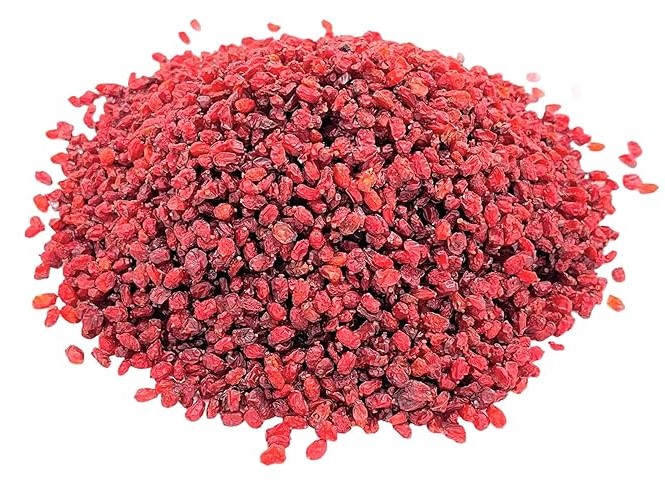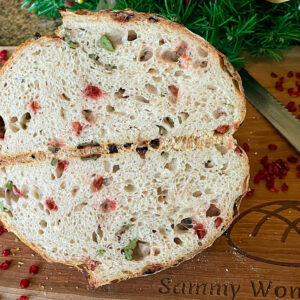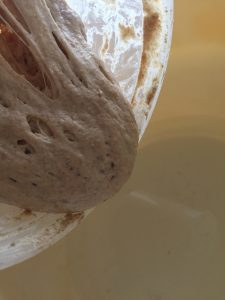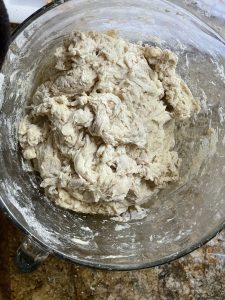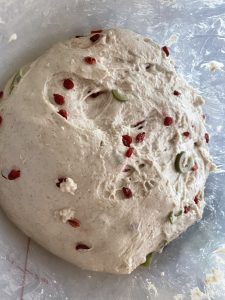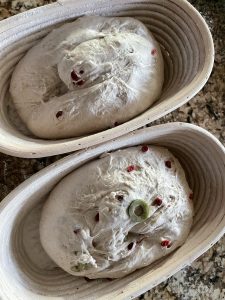1 Comments
share this

I love Christmas. People tend to be in a joyful mood and many people wear their red and green. I usually don't wear red, but for one month, I go overboard. This year I was trying to develop a non-sweet festive sourdough since I really don't eat Pannetone. The combination of these ingredients are very different, but they work as a savory bread. So, if you're looking for a sourdough for your avocado toast, bacon and eggs or as a side to your entree etc. this savory Christmas sourdough bread is worth trying.
Dried barberries and green olives are the ingredients that make this savory Christmas sourdough festive. The dried barberries bring some tart and the green olives brings some saltiness to the bread and together, they make and interesting and wonderful combination.
I also changed the technique to allow the sourdough to extract much of the micro-organisms in the wheat germ for maximum nutrition. It may take extra time to proof, but it's well worth the increase in nutritional value.
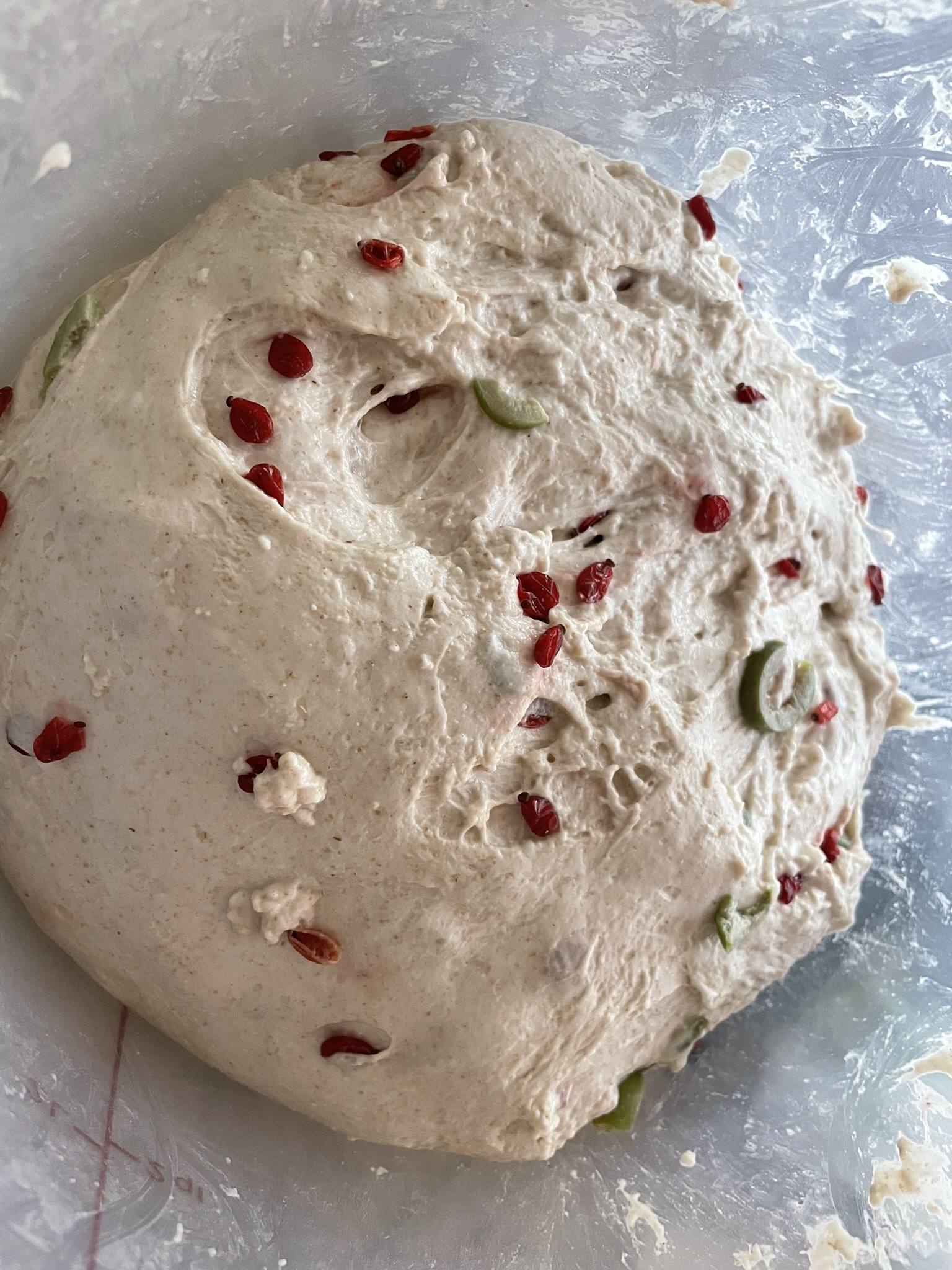
Savory Christmas sourdough bread dough
Tips for making Savory Christmas sourdough bread.
Adding Inclusions.
Dried barberries
Dried barberries are a mediterranean ingredient. I incorporate dried barberries or Middle eastern zereshk. One of my middle eastern neighbors brought rice with these barberries, and I just kept picking them out to eat. They are small and tart with just enough sour to make it interesting, and an incredible addition to the bread! However, if these are hard to come by in your neck of the woods, substitute for dried tart cherries, tart cranberries, dried pomegranate seeds etc. Just a word of advice, read the nutrition label. A low sugar dried cranberry may be loaded with artificial sweeteners!
The size of the berries are perfect since they are so small, they tend to permeate throughout the bread making it really festive with the green olives.
Since you want these berries to be uniformly distributed throughout the bread, it is best to add it during the stretch and fold process. This allows the berries enough time to be fully incorporated into the dough. However, add this before the third stretch and fold, because you want the dough to build strength first before you add these berries. Adding it too early will break some of the dough structure, resulting in a bread that may not rise well. Adding it at the end will result in a swirl of berries which may look good but would really be a mouthful of tart barberries!
Green olives.
Green olives are somewhat salty. I find that the most vibrant green olives are found at grocery stores that have an olive bar or deli. Bottled olives are brined a lot longer and as a result, the color is not as vibrant. If you are able to get green olives at the olive bar in your grocery store, make sure that they are pitted! (Pits removed) Otherwise, it will be a lot of extra work to remove those pits. Slice the green olives. Usually, with a salty ingredient, I would add this during the pre-shaping. However, since these green olives are mainly for color, and the bright green olives tend to be less salty (less marinated) than the paler green olives, I incorporate these during the stretch and fold process.
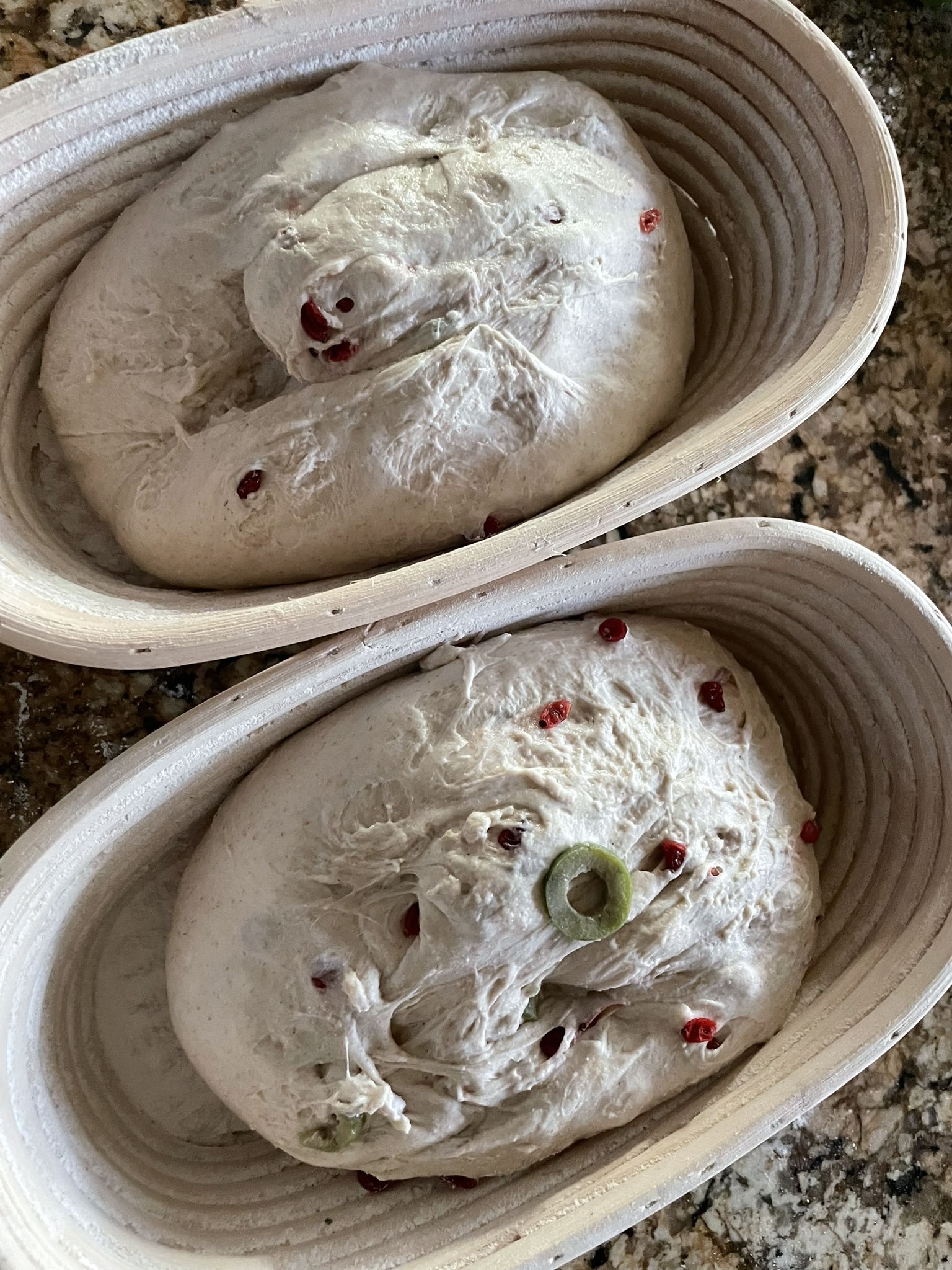
Savory Christmas Sourdough with barberries and green olives.
If you've tried making this bread, let me know what you think about this festive savory Christmas sourdough bread in the comment section.
SAVORY CHRISTMAS SOURDOUGH BREAD
Equipment
- Cast Iron dutch oven
- 2 Large Bowls
- Bread lame, razor or pair of scissors
- Dish towel to cover dough
Ingredients
- 350 grams water (80 degrees-lukewarm)
- 400 grams bread flour
- 100 grams whole wheat flour
- 9 grams salt
- rice / bread flour mixture Used for dusting your proofing bowl / banneton
- 100 grams levain See "What is levain and how to make it"
- 15 grams dried barberries
- 25 grams sliced green olives
- 15 grams water for hydrating dried barberries
Instructions
Preparing the inclusions
- Slice the green olives.25 grams sliced green olives
- Hydrate the dried barberries.15 grams dried barberries, 15 grams water
Making your bread dough
- Sift you bread and wheat flour into a bowl. I do this because some bread flours are very refined and clumpy. Sifting helps remove those clumps.400 grams bread flour, 100 grams whole wheat flour, 100 grams levain
- In another bowl, add your levain to your lukewarm water and stir to mix. It does not have to dissolve.350 grams water
- Mix in your flour mix and let sit for 45 minutes. This allows your dough to autolyze, allowing the flour to completely absorb all the liquid making it easier to work with.Set timer for 30 minutes
Kneading the bread dough.
- The dough is now ready for bulk fermentation where it will develop its flavor and body! Ambient temperatures between 70-80 degrees Fahrenheit will take 3 hours for bulk fermentation
- Add the salt after the dough has autolyzed.9 grams salt
- I knead the dough by hand...very therapeutic. Using wet hands, I pull and stretch the dough out at the top and fold it back on itself, I then rotate the dough a quarter turn and do the same thing 16 times. (4 complete revolutions!) Don't worry if the inclusions are not sticking to the dough. It will be incorporated ...eventually!
- Let dough rest for 30 minutes. You will notice that the dough will become more pliable with time. Cover and let sit for 30 minutes. Don’t forget to set your timer! Set timer for 30 minutes
- Add the dried barberries and sliced green olives.15 grams dried barberries, 25 grams sliced green olives
- Knead dough
- Let it rest for 30 minutes.Set timer for 30 minutes
- Knead dough
- Let dough rest for 30 minutesSet timer for 30 minutes
- Knead dough
- Let dough rest for 30 minutesSet timer for 30 minutes
- Knead dough
- Let dough rest for 30 minutesSet timer for 30 minutes
- Knead dough
- Let dough rest for 30 minutesSet timer for 30 minutes
- Knead dough. The dough should be soft and pliable. If not, continue bulk fermentation for another 30 mins - 1 hour.
Shaping your bread dough.
- Pull dough out of the container. You can make smaller bolles by using about 250 grams of dough (a half of your recipe) in a 2 quart cast iron dutch oven. See Cutting and Shaping your Dough in my Tips & Tricks section.
- On a floured surface, lightly dust your dough with flour and work it into a round by pulling it towards you and rotating. It should become somewhat taut as you pull the dough, part of your goal is to remove most of the air bubbles that were created during the fermentation process. I have found that if you keep these air bubbles, your bread will be very porous with a lot of air bubbles (almost like a ciabatta). Some people like this, other people want a little more substance.
- Let it sit for 20 minutes. Set timer for 10 minutes
- Shape again. See Cutting and Shaping your Dough in my Tips & Tricks section.
- Prepare your banneton (Coiled rattan baskets for proofing) by generously dusting the bowl or banneton with your bread and rice flour mixture. Dust the tops of your loaves with flour and place it in a bowl or banneton with the dome side on the bottom of the banneton.rice / bread flour mixture
Proofing your dough - Quick Proof
- Cover your banneton with a damp cloth and let rise in a warm place for 2 hours. I usually put this in my oven with the oven light on.Proof dough for 120 minutes
- Take your dough out and preheat oven to 500° fahrenheit (260° Celcius) with your cast iron dutch oven in it. (Should take about an hour depending to get your cast iron pot to the desired temperature.) This will be a total of 3 hours of proofing. I have proofed bread for 4 hours. However, overproofing your dough with cause your dough to lose its ability to have enough strength for the "oven-spring" (the last rise in the oven as a result of intense heat).
Proofing your dough - Slow Proof
- Allow dough to proof at room temperature for one hour before cold proofing.
- Place your banneton in a plastic bag. Seal it with a clip. Place it in the refrigerator for 36 hours.
- Preheat oven to 500° fahrenheit (260° Celcius) with your cast iron dutch oven in it. (Should take about an hour depending to get your cast iron pot to the desired temperature.
Scoring your dough.
- The dough should be fairly firm but not impossible to handle after proofing. Take a piece of parchment paper that will generously cover the top of the bowl/banneton. Crumple it so that it folds easily in the pot. Place it over the bowl/banneton.
- Flip the banneton over. The dough is now ready for scoring
- Dust the top of the dough with a little more flour if necessary or brush off excess flour from proofing. Score the bread by cutting it with a razor blade, bread lame, or a pair of scissors. Scoring the bread allows for oven spring when the dough expands quickly during baking and gives your dough a pretty design. See Scoring your dough in my Tips & Tricks section.
- Gently lower your scored bread into the dutch oven. If you have a cast iron skillet / dutch oven set as shown on my "Helpful Tools" section. After scoring, place the dough in the skillet of the set and cover the dough with the dutch-oven section. Place it in the oven with the skillet on the bottom.
- Cover.
Baking your bread
- Preheat oven temperature to 500°F
- Reduce oven temperature to 450°F
- Bake for 25 minutes. Smaller 2 quart bolles should bake for 20 minutes.Set timer for 25 minutes for large bolle Set timer for 20 minutes for small bolle
- Remove the lid and continue baking for an additional 25 or 20 minutes respectively.Set timer for 25 minutes for large bolle Set timer for 20 minutes for small bolle
- Remove from oven and remove from dutch oven and let cool on wire rack.
- To bake the second loaf, after removing the first loaf, bring the oven temperature back to 500 degrees, wipe the dutch oven with a clean dry towel, place the dutch oven in it for 10 minutes and bake according to recipe.
- Bread should cool for at least an hour before attempting to slice into it!
Notes
Nutrition
-
Pingback: Christmas Bread Recipes You'll Love
Need meal ideas?
EASY, HEALTHY, DELICIOUS!
DON'T MISS A RECIPE

